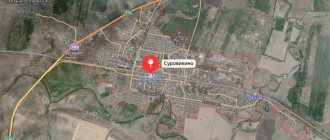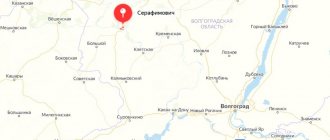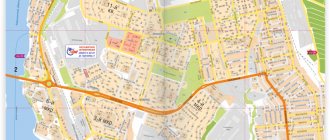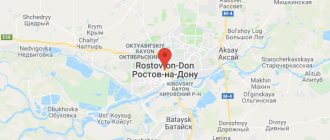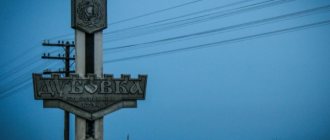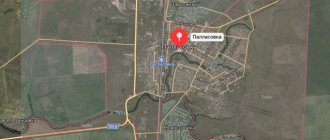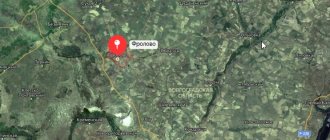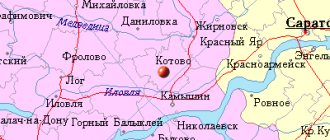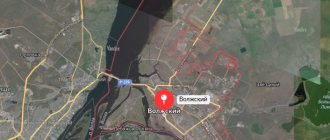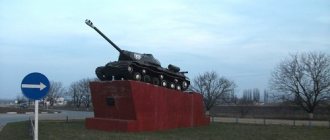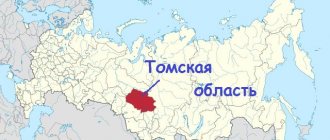About the name and coat of arms of the city Kalach-on-Don
According to legend, the name of the Cossack farm, which stood on the site of the current city of Kalach-on-Don, was given by Peter the Great himself. Legend has it that the sovereign rested here when he was transporting ships built in the Voronezh region along the Don to Azov. Peter I liked the kalach that the locals treated him to so much that he wished that the farm would now be called Kalachevsky.
Of course, most likely this is nothing more than a legend. In fact, Kalach-on-Don, like its namesake Voronezh city, got its name from the nature of the surrounding area. Here Don makes a sharp bend, or, simply put, turns it into a roll. There is evidence in the dictionary. Confirmation of this can be found in V.I.’s explanatory dictionary. Dahl: one of the meanings of the word “kalach” is described as “a round channel, an outflow that flows into the same river; a sharp bend of a river around an island or peninsula.”
The city's coat of arms on a special edition coin.
However, the coat of arms of Kalach-on-Don depicts both a bread kalach and a “river” kalach: a stylized bend of the Don. This coat of arms was adopted in 2006, at the suggestion of a deputy of the city duma and, perhaps, the most amazing resident of Kalach, Alexander Rukosuev (about him - in the section about the local puppet theater “Magic Lantern”). This coat of arms was depicted on a commemorative 10-ruble coin from the “Cities of Military Glory” series - “Kalach-on-Don” (issued in 2015 with a circulation of 10 million copies). The author of the final version of the city’s coat of arms was the artist Vladislav Khlustov.
From Moscow to the southwest of the Volgograd region to the city of Kalach-on-Don
The first time I tried to leave Moscow was on October 1, 2007. To Odessa. It didn’t work out, Belokamennaya didn’t let go. I wanted to leave exactly on October 1, exactly 10 years after my previous move from Dzerzhinsk, Nizhny Novgorod region, to Moscow. But this is a different story and it has long been outdated... So I left for Odessa on October 1, but a few days later I returned back... There were reasons for that. But the idea of leaving Moscow did not leave my head, tired of the Big City (BG).
There was no doubt that I would go strictly to the south, but here’s where... Odessa disappeared, because... was and is a city in another country, and, as recent and current events show, not the most predictable country. And not the safest... In second place was Bulgaria, fortunately the apartment had already been purchased in the city of Sandanski, in the South-West of Bulgaria. But again, a foreign country... In third place was Volgograd, this is where I am oriented, my grandmother lives here, I came here for the first time as a one-year-old baby... And then there was news that a decision had been made to complete the construction of the bridge across the Volga to Krasnoslobodsk. And this was supposed to raise real estate prices on the opposite side of the Volga from Volgograd, where the famous Volga-Akhtuba floodplain begins.
I started studying real estate. I see that prices have already gone up, our people are cunning. But after 8 years I will say this - prices have still risen more than everyone expected. Those. If I had bought something back then (in 2006-2007), the price would have doubled! But I didn’t dare... And so, while at a conference in Volgograd, during a conversation with my grandmother about my plans and dreams of moving somewhere, I voiced the idea of Poyma. To which my grandmother said that there are mosquitoes there and after the bridge is built, people will dirty everything... And she turned my thoughts to the city of Kalach-on-Don, arguing that this is the cleanest place in the Volgograd region.
I must say that throughout my childhood, while my Volgograd grandfather was alive, I regularly went fishing with him on the Don, in the Kalachevsky and Ilovlinsky districts. Those. I understood what we were talking about. Studying the Internet and maps of the area suggested that the idea was not bad. There was only one downside - a cold and windy winter! But, given my aging grandmother (she will be 90 this year), the move received an additional incentive in the form of caring for a loved one.
Panorama of the city of Kalach-on-Don. Photo by mmax95 (https://fotki.yandex.ru/users/mmax95/)
No sooner said than done. I started looking for houses in Kalach-on-Don, and then in the summer of 2008 an advertisement came up for the sale of a dacha in the Kalachevsky district. Plot of 20 acres (actually 26), two-story house, water (well and irrigation), electricity, gas in a cylinder. Plus a garage, an outdoor retro toilet, a utility room and a sauna. And a beautiful garden and vineyard. At the dacha I have almost everything - more than 40 types of grapes, cherries, apricots, peaches, nectarines, walnuts and hazelnuts, apples and pears, various currants and gooseberries, strawberries, etc. All this for 5,000 euros.
So, I spent the summer of 2008 at my new dacha, delving into the delights of gardening and viticulture. I would, of course, like to immediately buy a full-fledged house with all the amenities, but decent houses in Kalach-on-Don at that moment started at 40,000 euros. And I wasn’t sure that Moscow would let me go...
After spending the summer at a dacha in the Volgograd region, I became even more convinced of the correctness of my choice. And he began to look closely at decent houses. The wife agreed to move, but set one condition - a plot of at least 15 acres. Now she considers 6 acres as an eye-catcher, but then everything was different. The 2008 crisis continued to be unnerving with uncertainty. Some of the money was in rubles, some in euros. I liked one house in Kalach-on-Don on the Internet, I even looked at it and made an advance payment, but the owner eventually took the house off the market. I had to buy more euros and wait...
Bridge over the Don in the Kalach-on-Don area. Photo by make-aes (https://fotki.yandex.ru/users/make-aes/)
And then, in the early spring of 2009, a house appeared in the city center, with 15 acres, which is rare for Kalach-on-Don (the city is old and most plots are 5-8 acres). I didn’t delay, especially since I had to go to Volgograd again on business. I looked at the house, liked it, and for comparison I went to the Volga-Akhtuba floodplain and looked at real estate there. It seemed very overpriced... I bought the house for 50,000 euros, which was a bit high for Kalach, but inexpensive for Moscow. And given the central location, the large plot and the ruble that has begun to strengthen (and the savings are already in euros), I don’t regret it. My fence is the Kalach-on-Don police department, from the windows there is a view of the Philharmonic and the Children's Theater, the beach on the Don is a 10-minute walk, all the necessary shops are within walking distance (really)! In April 2009, I already received all the documents on the ownership of the house and land.
I didn’t rush to move; we left Moscow on June 6, 2009, and spent the summer at the dacha, because... I did a major renovation of the house in 3 months. And so on September 15, 2009, we moved into a house with gas heating, a modern bathroom with heated floors, air conditioning and other amenities of modern civilization. My wife admired the fall: +18 in October; the winter was not very cold, but the winds, of course, get to us... In the spring of 2010, the old chicken coop and other junk were demolished, and a swimming pool and a hammock appeared in their place. Planted several new trees in the garden... And began to live...
True, the next and all other winters (more precisely, from mid-January to April) I left Kalach-on-Don for Bulgaria, for Sandanski. It’s still much nicer there in the winter, but I always come back in the spring. And now, I’m writing this story on the Don.
Pros of my city:
1. Convenient transport accessibility - by rail, road and water. The train has really been cancelled, but the rails are there... Minibuses go to Volgograd every 15 minutes, the ride takes 1 hour 15 minutes, but there are 3 railway crossings, which always turns the road into a lottery - will you stop at the crossing? And how long will you stand? By car you can get to Volgograd (though not to the center) without moving in 1 hour. Rostov is 400 km away, along a decent federal highway. The port of Kalacha-on-Don is a port of 5 seas!
2. Good environment. There are no harmful industries, only the food industry. The most harmful thing is the port, because... theoretically there could be harmful cargo. But so far it practically doesn’t work...
3. Beneficial climate. Short, stormy spring; hot, long summer from May to September inclusive; long, sunny, dry and warm autumn. Winter begins in January and lasts until mid-March. There is little snow, during the winter you have to clean your car 2-3 times before leaving, mostly the snow melts on its own... The worst time is late autumn (mid-November - December), when it rains and there is little sun. I don’t like winter, but it is dry, sunny, cold (there are frosts down to -30) and windy. It’s worse in Rostov-on-Don, it rains heavily there in winter... And it’s much wetter. The fears about our heat are not entirely true. Yes, it's hot! But 2-3 weeks a year (usually in July). And, given the extremely low humidity and the evening breeze from the Tsimlyansk Reservoir, it (the heat) does not seem fatal. The main thing is to wear a hat! And don’t work in the heat in the sunshine (although people work in the fields!). Specific example. My wife's relative came from St. Petersburg in May. It was warm, +30 in the shade. I ask Lenka how much she feels the air temperature is. He says it’s about 22 degrees, “the best feeling.” I take him to the thermometer and show that it’s +30. It’s hard to believe, like in St. Petersburg at +30 I’d already be lying wet under the air conditioner!!! I myself can tolerate the heat of Krasnodar with its high humidity much worse than our steppe... And there are very few insects! Unlike the same Volga-Akhtuba floodplain, for example.
T-34-85 in Kalach-on-Don. Photo by Ilyich-3rd (https://fotki.yandex.ru/users/chernovkalach/)
4. Everything grows. I don’t bother with seedlings; most vegetables are planted directly in the ground. I’m too lazy to even install a greenhouse, because... Needed at best for 2-3 weeks (if without heating). Everyone knows Volgograd tomatoes! Watermelons too. By the way, the latter in wholesale are 2 rubles per kilo per season...
5. Don is wonderful. Anyone who has eaten Don fish is unlikely to want another! And the milk that the cows grazing along the banks of the Father gives is beyond description. You have to try this. For reference, the price for 5 liters is 200 rubles. From 5 liters of milk you get 1 kg of wonderful cottage cheese, we make it ourselves! You can swim in the Don from mid-May to mid-September; Sometimes the season is longer. For walruses - from the end of April until December! It freezes in mid-January, for Epiphany the city gathers on the beach, a bathhouse is cut into the shape of a cross and into the water!!!
6. Safe! This is a Cossack region, and the city is small. My children go to the store for ice cream themselves. There have never been any problems in 5 years. And 90 percent here are Russian people.
7. Costs of living and real estate are low. Apartments and houses - roughly 20-30,000 rubles per 1 sq.m. Those. One-room apartments cost a million, small houses with gas and water, too. More is proportionally more expensive. All prices are on the Internet, I am not a realtor, whoever is looking will find. Communal apartment - mother for an apartment of 72 sq.m. pays about 2000 rubles per month, + gas, water and electricity according to the meter. On average, my house costs about 2000-3000 rubles per month, including everything! For food, etc. (we are 2 adults and 2 children), if not luxurious, it costs somewhere around 10-15,000 rubles a month.
8. Nice people. They will always help and advise. True with laziness. But historically this is the former Don region, where the Don Cossacks lived and live. Really, according to Sholokhov (Kryukov?) - “What if there’s war tomorrow? And we are tired..."
9. Infrastructure for children. Small, but there. The main pride is the Children's Theater. There is a stadium, a children's creativity center and other children's clubs. Nice judo school! And last year they opened a new kindergarten, complete with a swimming pool! But there is no large swimming pool in the city yet, only in Volgograd...
10. All problems are solved easily and quickly. I didn’t notice much corruption. Changing a house gasification project, for example, costs 5,000 rubles and 2-3 days of work.
Minuses:
1. Cold and windy winter. The truth is not long - 2.5 months.
2. 3 railway crossings on the way to the regional center of Volgograd. There is a joke going around: Do you know why Hitler didn’t take Stalingrad? — The second crossing was closed!
3. Not a lot of work. But everyone lives somehow. No one goes hungry, the Don land will always feed you! A salary of 10,000 rubles is considered normal, 15,000 is considered excellent! There are businessmen, there are enough foreign cars. Because there are 2 large military units in the area. I am a special case, I am retired... For a long time...
4. Medicine is weak, but where is it good in small towns? More or less decent specialized medical care 70 km away in Volgograd. I treat all my children’s illnesses myself, even though I am a psychiatrist by training... Although there is a central district hospital and a new maternity hospital in the city.
Probably, if you are very critical, you can still find a bunch of shortcomings. But I probably don’t see them anymore. I wrote it in one breath, please forgive me if I lost the style somewhere.
About the history of the city
The year of foundation of the Kalachevsky farm is known precisely: 1708. This small Cossack settlement was part of the yurt of the village of Pyatiizbyanskaya of the Don Army. Nowadays, this village, on the contrary, is a small farm in the Kalachevsky district. Its natives were the heroic Cossack officers of the Denisov family, participants in all wars of the Russian Empire, including the Patriotic War of 1812. In the local church, the walls of which are still preserved, Stepan Razin was baptized.
The Kalachevsky farm remained a small Cossack settlement until 1862, when the Volga-Don Railway was built from Tsaritsyn to Kalach - the oldest currently operating railway in the Volgograd region. The population of the farm began to grow rapidly: thanks to the local railway station - on the branch that connected the Volga with the Don, its strategic importance grew disproportionately. According to 1897 data, there were 553 households and 2,319 residents; three steamship piers on the Don; post and telegraph.
Center of Kalach-on-Don, 1951: in front of the Volgo-Don cinema building there is a monument to Stalin.
During the civil war, Kalach played a big role in the defense of red Tsaritsyn. The city became the scene of bloody battles between the Red Army and the rebel Cossacks, changing hands at least eight times. Kalach also played a great role in the Battle of Stalingrad. On August 26, 1942 Kalach was occupied by the Nazis. After stubborn battles, on November 23, 1942, our troops liberated the city; on the same day, as part of Operation Uranus, a “cauldron” ring closed near Kalach, into which Paulus’s group fell.
In 1951, the village of Kalach was renamed Kalach-on-Don, and it was given the status of a city. This was directly related to the completion of one of the Soviet “constructions of the century” - the Volga-Don Shipping Canal named after V.I. Lenin (here is the last lock before connecting the canal with the Don). After the establishment of the title “City of Military Glory,” Kalach-on-Don became one of such Russian cities (according to Decree of the President of the Russian Federation dated March 25, 2010 No. 342).
Triumphal Arch at the end of the Volga-Don Canal: the “gate” to the Don.
History of education and development
The city, which was originally a Cossack farm, was founded in 1708 and was named “Kalach”. By 1859, about five hundred people lived in the farmstead. Two churches were erected in Kalach, and in 1862 a railway line was laid connecting the settlement with Tsaritsyn. Currently, this branch is still functioning and is considered the oldest in the region. According to the census, by 1873 Kalach was inhabited by more than a thousand people, and by 1897 by more than five thousand.
During the Civil War, a large-scale Cossack uprising broke out in the farmstead, which became one of the decisive ones in the events of the defense of Tsaritsyn. During the battles, Kalach moved from one opposing side to the other about eight times. In 1919, the farm was annexed to the Tsaritsyn province, and in 1928 it became the regional center of the Kalachevsky district.
During the Great Patriotic War, the city played an important role in the fierce and bloody Battle of Stalingrad. At the beginning of the battle, he was a desired trophy for the advancing fascist troops, the battles with which took place on the borders of the city. The Soviet troops defending Kalach were surrounded and this caused huge losses.
In the summer of 1942, Red Banner divisions arrived at the front to protect the approaches to Stalingrad from the German invaders who continued their offensive in the vicinity of Kalach, but due to the haste during the transfer, they were surrounded. Many fighters died in these battles, and more than 55,000 survivors were captured. By the end of the summer of 1942, the settlement was occupied by the troops of Nazi Germany, but by the end of November of the same year it was liberated.
In 1951, the village acquired city status.
Lock No. 13 of the Volga-Don Shipping Canal
Lock No. 13 of the Lenin Volga-Don Shipping Canal is located a few kilometers from Kalach, near the village of Pyatimorsk. This is the last lock of the canal, after passing which ships coming from the Volga enter the Don River. At the entrance to the canal from the Don, beacons are installed at the ends of the enclosing dams. The five-kilometer-long earthen dams of the supply canal are lined with double rows of pyramidal poplars, which creates a large “water” alley, which is closed by gateway No. 13. The control buildings of gateway No. 13, like gateway No. 1, are made in the form of a magnificent triumphal arch, being the ceremonial “gate” to canal from the Don side.
Gateway No. 13.
The arch is decorated with bas-reliefs; There are inscriptions on it: “Glory to our great Motherland” - when approaching from gateway No. 12, and “Glory to the victorious Soviet army” (in memory of the fierce battles that took place here during the Battle of Stalingrad) - when approaching from the Don River.
Monument "Union of Fronts"
In 1953-1955, on the right bank of the outport of lock No. 13 of the Volga-Don Shipping Canal, the majestic monument “Union of Fronts” was erected. It is dedicated to the significant event of the Battle of Stalingrad - the historical meeting of units of the Southwestern and Stalingrad fronts, which took place on November 23, 1942 near Kalach. This connection completed the encirclement of the fascist group and became the beginning of its complete defeat.
The monument is located 12 kilometers from the historical junction of the fronts, as it was flooded by the Karpov Reservoir in the early 1950s, during the construction of the Volga-Don shipping canal. The author of the monument is the great sculptor, People's Artist of the USSR Evgeniy Vuchetich (he also headed the construction of the monument-ensemble "To the Heroes of the Battle of Stalingrad" on Mamayev Kurgan, was the author of the "Warrior-Liberator" in Berlin's Treptower Park, and the sculpture "Let's Beat Swords into Plowshares" near the building UN in New York, and many other outstanding works).
Monument "Union of Fronts".
The multidisciplinary 16-meter sculptural monument depicts four soldiers from different units at the moment of the ceremonial meeting of two fronts. This is a motorized rifleman, horse guardsman, infantryman and tankman. Behind them are the banners of the fronts. The monument is installed on an 11-meter-high embankment hill, formed from soil obtained by digging the bed of the Volga-Don Canal. A long staircase leads to the foot of the memorial, and large stone pedestals with inscriptions are installed on the sides of the monument. Next to the monument there is a Cyril and Methodius cross by sculptor Vyacheslav Klykov in memory of the fallen soldiers.
The monument was restored in the 2000s, the area around it is well-groomed and landscaped. Over the years since the war, this majestic memorial has been visited by a huge number of people from all over the Soviet Union. Many of them are to pay tribute to the memory of their relatives who laid down their lives in this Don steppe. After all, the victory came at a high price. Descendants of generals and marshals of the USSR - participants in the Battle of Stalingrad - have also been here many times. Busts of Zhukov, Chuikov, Vasilevsky, Rokossovsky, Vatutin, Rodimtsev and other commanders also stand here, on the Walk of Military Glory of Victory Park.
Map
| Kalach-on-Don: maps |
Kalach-on-Don: photo from space (Google Maps) Kalach-on-Don: photo from space (Microsoft Virtual Earth)
| Kalach-on-Don. Nearest cities. Distances in km. on the map (in brackets along roads) + direction. Using the hyperlink in the distance , you can get the route (information courtesy of the AutoTransInfo website) | |||
| 1 | New Rohachik | 38 (41) | IN |
| 2 | Surovikino | 51 (65) | Z |
| 3 | Settlement | 70 (87) | IN |
| 4 | Volgograd | 71 (80) | IN |
| 5 | Krasnoslobodsk | 75 (140) | IN |
| 6 | Ilovlya | 76 (165) | NE |
| 7 | Oblivskaya (Rostov region) | 77 (103) | Z |
| 8 | Kletskaya | 77 (163) | NW |
| 9 | October | 80 (185) | YU |
| 10 | Erzovka | 86 (113) | IN |
| 11 | Volzhsky | 91 (108) | IN |
| 12 | Svetly Yar | 94 (133) | IN |
| 13 | Srednyaya Akhtuba | 97 (105) | IN |
| 14 | Chernyshkovsky | 100 (101) | Z |
| 15 | Dubovka | 103 (133) | NE |
| 16 | Sovetskaya (Rostov region) | 109 () | Z |
| 17 | Serafimovich | 115 (189) | NW |
| 18 | Malye Derbets (Republic of Kalmykia) | 117 () | SE |
| 19 | Frolovo | 120 (225) | WITH |
| 20 | Kotelnikovo | 120 (234) | YU |
a brief description of
Located on the left bank of the Tsimlyansk Reservoir, 9 km above the entrance to the Volga-Don Canal named after Lenin, 85 km west of Volgograd. River port. Railway Donskaya station.
Territory (sq. km): 74
Information about the city of Kalach-on-Don on the Russian Wikipedia website
Historical sketch
It arose in 1708 as a Cossack settlement Kalach (Kalachevsky farm). The name comes from the popular geographical term kalach “a steep bend of a river around an island or peninsula” - this kalach existed at the farm before the formation of the Tsimlyansk reservoir.
In ATD-1945, the Kalach-on-Don farm. Since 1951, it has been a city, to which, to distinguish it from the city of the same name in the Voronezh region, an indication of its location on the Don was added.
During the Great Patriotic War, intense fighting took place in the Kalach-on-Don region in August 1942. On August 26, 1942, the city was captured by Nazi troops and liberated after stubborn fighting on November 23, 1942.
South-east of the city (in the area of the village of Sovetsky) a junction of troops of the South-Western and Stalingrad fronts took place, completing the encirclement of the Nazi troops at Stalingrad. The “Union of Fronts” monument was erected at this place (sculptor E.V. Vuchetich).
Economy
Factories: shipbuilding, ship repair, metal structures, JSC "Zhelezobeton", JSC "Alternativa" (furniture), "Donmoloko". Meat processing plant.
In the Kalachevsky district, wheat, barley, corn, rye, mustard, vegetables, and fruits are grown. They raise cattle, pigs, and sheep.
Culture, science, education
Puppet Theatre.
Museums, galleries, exhibition halls
Kalachevsky Museum of Local Lore 404507, Volgograd region, Kalachevsky district, Kalach-on-Don, lane. Voroshilova, 5 Phone(s): (8-272) 332-20 Website: https://vokm134.ru/
Architecture, sights
In the Kalach-on-Don area there is a monument “Union of Fronts” (sculptor E.V. Vuchetich).
| Population by year (thousands of inhabitants) | |||||||
| 1939 | 7.0 | 1996 | 25.0 | 2007 | 26.6 | 2015 | 25.1 |
| 1959 | 16.7 | 1998 | 25.3 | 2008 | 26.6 | 2016 | 24.7 |
| 1967 | 21 | 2000 | 25.4 | 2010 | 26.2 | 2017 | 24.2 |
| 1970 | 20.8 | 2001 | 25.3 | 2011 | 26.9 | 2018 | 23.9 |
| 1979 | 22.8 | 2003 | 26.9 | 2012 | 26.7 | 2019 | 23.8 |
| 1989 | 23.0 | 2005 | 26.6 | 2013 | 26.2 | 2020 | 23.6 |
| 1992 | 23.5 | 2006 | 26.6 | 2014 | 25.6 | 2021 | 23.5 |
Stele Kalach-on-Don – City of Military Glory
This 12.5-meter monument was inaugurated in November 2017, on the 75th anniversary of the historical union of the fronts. The top of the stele is decorated with the Coat of Arms of the Russian Federation, the lower part of the monument is decorated with the text of the Presidential decree conferring the title “City of Military Glory” on Kalach-on-Don, and on the other side is the coat of arms of the city. Along with the governor, this monument was opened by veterans of the Great Patriotic War: 93-year-old Ivan Ivanovich Popov and 91-year-old Vasily Parfenovich Borodin (holder of two Orders of Glory, Honorary Resident of the city).
Stele Kalach-on-Don - City of Military Glory.
Location: Boulevard of the 300th anniversary of Kalach-on-Don, between Revolutsionnaya and Oktyabrskaya streets, not far from the monument to Soviet tank crews.
Kalach-on-Don
City of Military Glory
In 2022, due to the pandemic, public events in honor of the city day are canceled or may be postponed
Kalach-on-Don
is a Russian city in the Volgograd region, the administrative center of the Kalachevsky district, located 85 kilometers west of Volgograd. The city is located in a bend of the Don, on the left bank of the Tsimlyansk reservoir.
The city appeared as a Cossack settlement Kalach in 1708
. There are two versions associated with the appearance of the name of the farm. It most likely comes from the geographical term "kalach", which means a steep bend of a river around an island or peninsula. It was just such a meander that existed in the village before the Tsimlyansk Reservoir appeared. They also say that the farm could have received its name thanks to Peter the Great. Driving the fleet from Voronezh to Azov, Peter I stopped here for some time. The king was treated to all kinds of dishes, but most of all he liked the kalach, so much so that he ordered the farm to be named after it.
In the mid-19th century, the first railway in the Volgograd region, the Volga-Don Railway, was built here. In 1951, the farm received city status and was renamed Kalach-on-Don.
In 2010, Kalach-on-Don received the honorary title of “City of Military Glory”
.
Among the attractions
The city has many monuments dedicated to the Great Patriotic War and the Battle of Stalingrad, the Kalachevsky Museum of Local Lore.
Russian painter Valery Kulchenko, theater actress Nina Neznamova, Hero of the Soviet Union Viktor Suzdalsky were born here.
Day of the city
Kalach-on-Don is celebrated on the last weekend of August.
Source
Monument to Soviet tank crews (T-34)
The monument to Soviet tank crews in Kalach-on-Don is a T-34/85 tank mounted on a pedestal. It is located in front of the three-story building of the local vocational school.
Monument to Soviet tank crews in Kalach-on-Don. Behind him is the building of SPTU No. 13.
Address: st. Oktyabrskaya, 271.
Educational institutions
Educational institutions in the city of Kalach-on-Don include:
- 7 kindergartens;
- 4 schools;
- 2 institutions providing secondary specialized education.
In addition, the village has children's sections and clubs, a dance studio, an art school, a children's art house, a youth center and a city stadium.
The first Soviet monument tank in history (T-70)
The pedestal with the T-70 tank was installed by soldiers of the 26th Tank Corps on the mass grave of their comrades, in which more than 240 tankers were buried. A meeting dedicated to the opening of the tank monument took place on December 12, 1942. The T-70 light tank was one of the combat vehicles directly involved in the battles of Operation Uranus. It was installed at the mass grave on December 8, 1942, by order of the commander of the 152nd tank battalion, Captain Gladchenko. In accordance with this order, the pompotech of the battalion, Bondarenko, allocated a combat vehicle that had preserved its appearance for the monument, from among those that could no longer be restored. This T-70 became the first tank-monument in the history of the Great Patriotic War. Both he and the pedestal have been preserved to this day in their original form.
An article in Komsomolskaya Pravda (January 1943) about this event.
Address: Fallen Fighters Square, 7a.
The heroic T-70 tank, a participant in the Battle of Stalingrad, in our days.
Square of Fallen Fighters and Park "Alley of Heroes"
As in Volgograd, the central square of Kalach-on-Don is called the Square of Fallen Fighters, and the Alley of Heroes leads to it. The scale, of course, is not so significant, but this memorial, dedicated to those who died in the Great Patriotic War, is no less majestic. More than 15 thousand natives of the Kalachevsky district fought on the war fronts, more than 9 thousand of them died. 17 soldiers received the title of Hero of the Soviet Union (8 of them posthumously). The main part of the memorial exhibition is the Eternal Flame.
Kalach-on-Don
Useful
See what “Kalach-on-Don” is in other dictionaries:
KALACH-ON-DON is a city (since 1951) in the Russian Federation, Volgograd region, a port on the Tsimlyansk reservoir. Railway station (Donskaya). 23.5 thousand inhabitants (1992). Ship repair shipyard, food enterprises. Founded in 1716 ... Big Encyclopedic Dictionary
KALACH-ON-DON - KALACH ON DON, a city (since 1951) in the Volgograd region, a port on the Tsimlyansk reservoir. Railway station (Donskaya). 25.3 thousand inhabitants (1998). Ship repair shipyard, food enterprises. Founded in 1716. Source: Encyclopedia Fatherland ... Russian history
Kalach-na-Donu - noun, number of synonyms: 1 • city (2765) ASIS Dictionary of Synonyms. V.N. Trishin. 2013 ... Dictionary of synonyms
Kalach-on-Don - City of Kalach on Don Coat of arms ... Wikipedia
Kalach-on-Don is a city (since 1951) in Russia, Volgograd region, port on the Tsimlyansk reservoir. Railway station (Donskaya). 25.3 thousand inhabitants (1998). Ship repair shipyard, food enterprises. Founded in 1716. * * * KALACH ON THE DON KALACH ON... ... Encyclopedic Dictionary
Memorial sign-howitzer at the entrance to Kalach-on-Don
After Kalach was awarded the title of City of Military Glory, the idea was realized to supplement the stele with the name of the city, standing at the entrance, with a memorial sign demonstrating its new status. The initiative came from A.G. Rukosuev and his puppet theater “Magic Lantern”. Artists created a life-size model of an M-10 howitzer using cardboard and papier-mâché. Then, focusing on this model, the welders made mounting parts from metal, and welded them into a “real” howitzer.
A memorial sign-howitzer at the entrance to Kalach-on-Don.
Employment
In the city of Kalach-on-Don there is a ship repair yard, a river port, a meat processing plant and a bakery. In addition, agriculture is widely developed in the settlement and its surroundings, which includes pig and sheep farming, as well as wheat, corn, barley, mustard, rye, fruits and vegetables.
All these enterprises provide vacancies to job seekers of different levels of education and professional skills. There is also a network of public catering and fast food establishments in the city, which provide employment for those interested in positions of various skill levels.
Museum of Local Lore
The Kalachevsky Museum of Local Lore was officially opened in 1972, on the eve of the 30th anniversary of the liberation of Kalach-on-Don from fascist troops. But the collection of materials about the historical past of the city began much earlier. In 1965, the Museum Council was created under the city administration. In 1968, the house of merchant S.I. Kravchenko, built in 1890, was allocated to the future museum. From 1969 to 1972 this building was completely renovated.
Museum of Local Lore.
The museum has 7 exhibition halls, including an Art Gallery of local painters. The museum collection includes more than 10,000 items, including unique monuments of nature and history of the region. Thematic collections: paleontology, archeology, household items of the Don Cossacks of the late 19th and early 20th centuries, items from the period of the Great Patriotic War. Temporary ones are dedicated to the works of local artists and craftsmen.
Museum opening hours. Monday-Friday: from 9:00 to 18:00, lunch: from 13:00 to 14:00, weekends: Saturday and Sunday. Address: per. Voroshilova, 5.
Stories about hero cities and cities of military glory. Kalach-on-Don
This city played an important role in the Battle of Stalingrad.
The Battle of Stalingrad began in the vicinity of the city of Kalach-on-Don. After its capture, the fascist command planned to use it as a springboard to accumulate forces before attacking Stalingrad, the path to which through Kalach-on-Don is the shortest. The Germans only needed to capture the bridge over the Don, and, having crossed it, cover another 75 kilometers. In the middle of the summer of 1942, there were terrible battles for crossing the Don.
“Our Soviet troops stopped the Nazis at a front stretching 800 km, i.e. the main forces of the fascist troops were drawn into the hardest, bloodiest battles in the interfluve of the Volga and Don,” says Veronika Nikitina, head of the Kalachevsky branch of the Volgograd Regional Museum of Local History.
Soviet soldiers managed to push the Germans back several kilometers from the crossing of the Don. As a result of 13 days of continuous fighting on the approaches to Kalach, the plans of the German command to take Stalingrad outright were thwarted. But in mid-August, enemy aircraft launched a massive attack on the location of our troops. Several days of fierce bombing. It seemed that there was no one to defend the crossing and the city, but the soldiers stood to the end and only after receiving the order to retreat did they leave.
In September 1942, Kalach-on-Don was occupied by invaders. There is a lot of evidence stored in the Volgograd regional archive that tells about the Nazis’ abuse of the civilian population. For any disobedience - execution. 200 children killed during three months of occupation. Pyotr Mikhailovich was a boy then. He was lucky - he survived and remembers only severe beatings.
“The Germans take me: tell me, who else was with you, what did you do? They beat me so hard that I lost consciousness twice,” recalls local resident Pyotr Silkin.
The counteroffensive of the Soviet troops began unexpectedly for the enemy. On the morning of November 19, 1942. German positions were shelled by 3,500 guns and mortars for almost an hour and a half. This was the beginning of Operation Uranus, developed by the Headquarters of the Supreme High Command to eliminate the Stalingrad group of fascist troops.
On November 23, Kalach was released. Lightning fast. On the same day, the historic unification of the Southwestern and Stalingrad fronts took place, closing an encirclement ring around the enemy group. Thus, 330 thousand enemy soldiers were cut off from their troops, these are 22 divisions and 160 separate units. They will no longer be able to escape from this ring. The Battle of Stalingrad ended where it began - near the small town of Kalach-on-Don.
Church of St. Nicholas the Wonderworker
In tsarist times, in the Kalachevsky farm there was a large church (St. Nicholas the Wonderworker) and a monastery (from the beginning of the 19th century - for men, and at the end of the 19th - beginning of the 20th century it was converted into a women's one). St. Nicholas Church, where the parochial school operated, stood on the site of the current Philharmonic, and the monastery monastery - on the territory of the current water workers' hospital.
The Soviet government opened a club in the church building (the dome and bell tower were dismantled), and located a district hospital with 60 beds in the monastery premises. The hospital was completely destroyed during the Battle of Stalingrad, but the temple survived. Moreover, one of the powerful aerial bombs exploded very close to him: the edge of a crater with a 25-meter diameter passed 5-6 m from the church wall. However, the church burned down in 1946 due to a child’s prank with fire, and in 1947 the Volgo-Don cinema was built on its foundation.
Church of St. Nicholas the Wonderworker.
Construction of a new large city church began in October 1990. It lasted for many years. On February 14, 2008, the main dome was installed, in the same year a new iconostasis was erected, ornamental painting of the walls was done, and a fence was built around the church. On April 26, 2011, the temple was consecrated by Metropolitan Herman. In 2014, St. Nicholas Church was given the status of a cathedral. Kalachevskaya diocese.
Address: st. Revolutionary, 293.
Kalachevsky Philharmonic
The Kalachevsk City Philharmonic was organized in 1999, thanks to the enthusiasm of a small group of like-minded people - cultural workers. In 2007, the Philharmonic Society was given part of the building of the Volgo-Don cinema, and it got its own concert hall, as well as a mounted stage for performances in open areas. Significant funds were allocated by the administration for the purchase of musical instruments, lighting and sound equipment. The Philharmonic began to operate its own recording studio, where all arrangements for concerts are recorded.
Kalachevsky Philharmonic.
As a result, the Kalachevsk City Philharmonic Society became a developed cultural institution, atypical for a provincial town, working in various genres of musical, theatrical and choreographic art. Along with the main direction of its activity - organizing concert and creative events, the Philharmonic implements programs for teaching and training children in the field of musical and choreographic art. Children's and youth creative groups have been formed at the Philharmonic, many of whose graduates have continued their creative careers in regional centers, Moscow and St. Petersburg.
Address: st. Oktyabrskaya, 94b.

